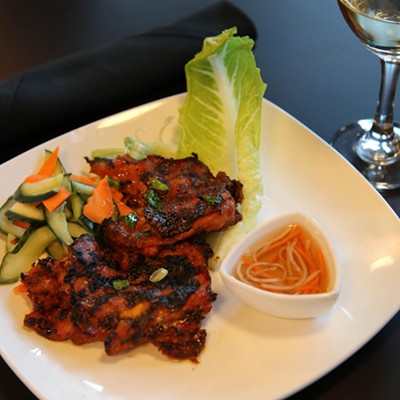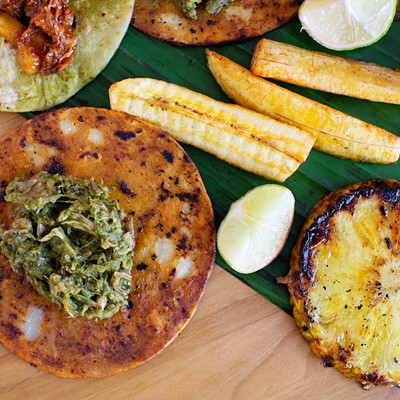Gosh, how I love what some restaurant owners will put on their menus, trying to create a certain lore. And this bit of prose, from the C.I. Chu's Mongolian Barbeque, is better than most.
Now, this thing about Mongols frying up dead critters on shields very well could be true, even though the thought gives me one primary reaction (ewwww!). But I am pretty sure that Mongolian barbecue is not that original, nor is it one of the world's least-known dining experiences, seeing as I've been eating Mongolian barbecue since the '80s, when I first had it in Reno, Nev. It can also be found in a number of casino buffets around Nevada, and that fact eliminates it from the "world's least-known" category right there.
But enough about this menu blurb. The issue at hand: Is C.I. Chu's Mongolian Barbeque any good? The answer, yes, it is, although there is a bit of room for improvement.
Officemates Laurel Allen and Irene Messina joined me for a recent weekday lunch to check out C.I. Chu's, which opened about three months ago on East Broadway Boulevard. It's a sister operation to the Iron Grill Mongolian Barbeque, on Tanque Verde and Sabino Canyon roads, so they should know what they're doing.
The décor at C.I. Chu's fits the "modern Asian stereotype" genre, if there were such a genre. Bright red and yellow dominates the wall colors, providing a striking contrast to the black ceiling, and gigantic metal frames surround images of nature scenes. It's nice, although the adult contemporary music playing overhead--"Long Run" was one tune--struck me as neither Mongolian nor barbecue, although Irene said she liked it.
Now, here's how the restaurant works: After you walk in the door, you grab a bowl and go through a salad-bar-style line, getting all the fresh vegetables you want. Then, with a pair of tongs, you get your meat--pork, chicken or beef, all in frozen slices--or tofu, if you're a vegetarian type. Finally, you douse your bowl with various liquids to make up one of the restaurant's several suggested sauces, which are written on a wall board. For example, the Chu's Choice sauce recipe is three scoops of chef's sauce, 1 1/2 scoops of sugar water, one scoop of cooking wine, one scoop of garlic water, one scoop of ginger water and one scoop of sesame oil. Pineapple and teriyaki are other sauce ingredients. After the dousing, you give the gentleman (it was a dude on this day, at least) your bowl to cook up, and he gives you a metallic tchotchke with a number on it. Then, the other folks behind the counter give you the accompanying soup (your choice of egg drop or hot and sour), rice (white or brown) and bread (a flat sesame pastry that reminded me of naan). Finally, you get your drink and pay: $6.99 for one bowl or $9.99 for all you can eat. The menu clarifies that lunch, from 11 a.m. to 5 p.m., is a one-bowl affair, that dinner is all-you-can-eat and that takeout is always one bowl, but they seem flexible on at least some of this; I was there for lunch, and they let me pay the $9.99 to get all you can eat.
Then you can watch them barbecue your food on the large, flat, circular metal surface, or you can go sit down, and one of the nicely dressed servers will bring your cooked bowl to you, knowing which bowl goes to which person/table based on the metal numbers.
How does it all work out? If you like stir-fry-type dishes, then this is for you. Irene and I each enjoyed our various concoctions. Laurel's beef dish met her approval, and Irene enjoyed hers, too. (Laurel did make one good observation after sampling the tofu: Tofu tends to soak up flavors, but in Mongolian barbecue, the tofu isn't around any ingredients long enough, meaning it tends to be a bit plain.) My pork bowl, also containing onions, mini corn cobs, sprouts, mushrooms and the aforementioned Chu's Choice sauce, hit the spot--although I was glad I got all you can eat, as the dish cooks down quite a bit. (Word to the wise: If you're doing the one-bowl thing, fill up that puppy.) My second bowl, with beef and the Tantalizing Teriyaki sauce (two scoops of chef's sauce, one scoop of sugar water, one scoop of cooking wine, one scoop of ginger water and two scoops of teriyaki sauce) along with a bunch of veggies, was tasty as well. The bottom line: Mongolian barbecue is hard to mess up, as long as the vegetables and meats are fresh, and this was the case at C.I. Chu's. Not only that, but the prices are reasonable--an affordable, simple yet delicious meal.
However, as previously noted, C.I. Chu's could do better. For one thing, while the bread was outstanding, the soups were merely so-so--Irene said her egg drop soup was a bit too salty, while the hot and sour soup was tangy yet unspectacular, as if it was missing something. The whole make-your-own-sauce experience can be a problem if you're on the wrong side of the two-sided ingredients bar, meaning you keep having to look over your shoulder to see the recipes on the wall. And finally--please note I am something of a clean freak when it comes to restaurants--on our visit, the metal number things were covered with bits of food from previous diners. The folks at C.I. Chu's would do best to wash them after each use.
All of these are fairly minor points. Overall, our lunch at C.I. Chu's was a fine time--even if we didn't feel much like Mongolian troops enjoying a unique dining experience.










